
How to raise baby chicks
Baby chicks! Even if your goal is to eventually own a flock of egg-producing hens, there is still something delightful about raising young chicks from "scratch" (pun intended). While some hens are willing to hatch and raise their own chicks, let's assume you're raising the baby chicks yourself—either chicks you've purchased or chicks from fertile eggs that you've hatched in an incubator. No matter how you got them, raising chicks is a rewarding experience. Here are a few pointers to keep in mind.

Keep them warm
It's important to consider the question: how warm do baby chicks need to be? Since your chicks are in a brooder (a chick-safe box where they will live until they get older) and not under the supervision of a mother hen, it's your job to provide them with the correct temperature. When chicks hatch, their bodies are covered in soft down, but they lack true feathers, and feathers are necessary for a chicken to regulate its body heat.
For the first week, you want to aim for a temperature of about 95 degrees in your brooder. As your chicks grow, you can reduce this temperature in five-degree increments once a week for the first month.1 You can assist the chicks in achieving the ideal temperature by providing them with an appropriate heat source, such as a heat lamp with a thermostat or timer or a Thermo-Poultry Brooder. In their first weeks, baby chickens should be heated from above. After the chicks are one month old, graduate them from the Thermo-Poultry Brooder to the Thermo-Peep Heated Pad.
Remember, heat source safety is paramount! And be sure to monitor how the chicks behave. Are they clustered together in a group? Are they huddled around the heat source? Are they spread out around the brooder and panting? Are they happily milling around? If chicks are too cold, they will huddle together for warmth. Chicks that are too hot will try to escape to the walls of the brooder. Also, avoid drafts!
Keep them comfy
Your chicks need a soft, fluffy surface for bedding, and pine shavings usually work well for this. Pine shavings are easily obtained from animal or livestock supply stores and are relatively inexpensive for the small amount you'll use in a hobby-scale brooder. While there are other alternatives (sand, for example), pine shavings are very absorbent, smell great, and are easy to clean up. Be sure to choose bedding that is appropriate for use with your heat source.
Provide water
Fresh, clean water is vital for the success of your chicks.2 Happily, you don't have to reinvent the wheel; others have created simple, effective designs for chick waterers. Waterers like these are generally circular in shape and allow multiple chicks to access the water at once without crowding each other. If you have a large population of chicks, you may need several waterers placed at different ends of the brooder. Waterers also help prevent chicks from drowning. When you first bring your chicks home, you'll want to physically show each one where the water source is.3
Choose the right feed
Your growing chicks have to eat, and most folks use a type of “chick-starter" feed for this. It's basically a blended mix of grains and supplements served in a crumble or mash form. You can research how to make your own chick starter or you can choose to serve a commercial variety. You shouldn't use a type of feed designed for laying hens, as this type will contain extra calcium (for eggshell development) that isn't good for chicks.
Keep it all clean
It requires some effort to learn how to take care of a baby chick, and one of those chores is cleaning. You want to provide a clean environment for the chicks in all respects: clean feeders, clean waterers, clean bedding, and clean walls of the brooder.3 This isn't always easy. It will seem like the chicks do their best to undo your efforts, but stay with it! The rewards and satisfaction of raising these chicks yourself are more than worth it.
- University of New Hampshire Cooperative Extension. "Brooding and Caring for Chicks," 2017. https://extension.unh.edu/resource/brooding-and-caring-chicks
- Damerow, Gail. Storey.com, "Chick Care: Feeding and Watering Dos and Don'ts," https://www.storey.com/article/chick-care-feeding-watering-dos-donts/
- Arcuri, Lauren. TheSpruce.com, "Raising Baby Chicks: The Basics," 2019. https://www.thespruce.com/raising-baby-chicks-to-laying-hens-3016584
